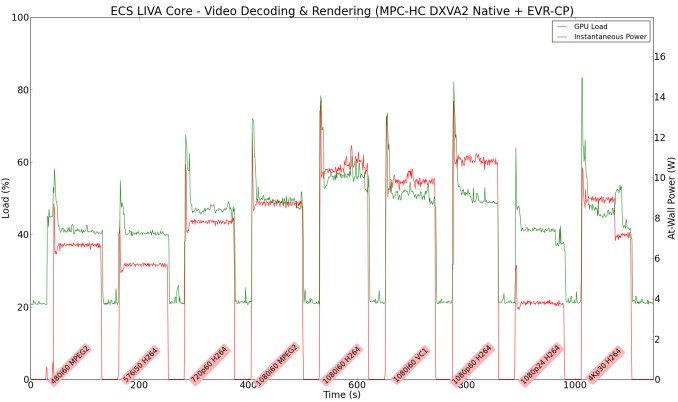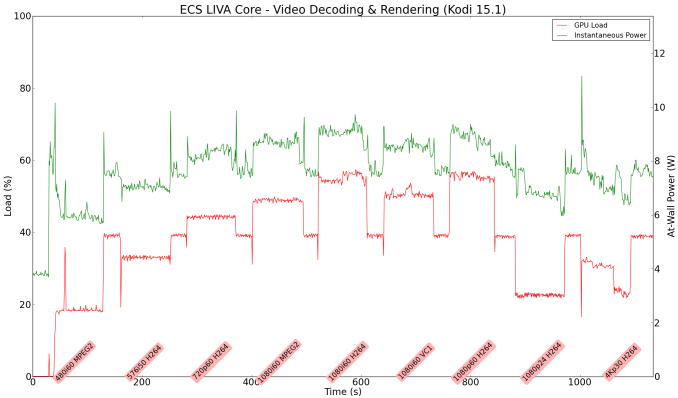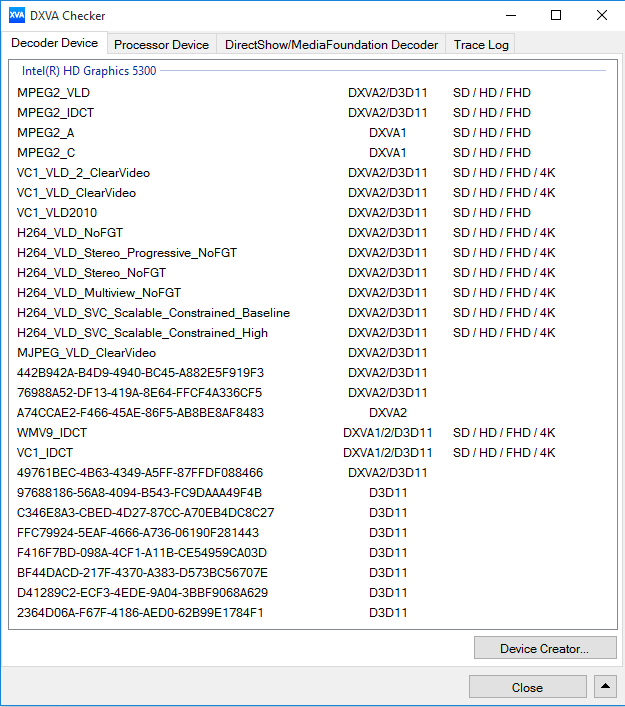ECS LIVA Core Review: A Fanless Core M mini-PC
by Ganesh T S on October 7, 2015 8:00 AM ESTHTPC Credentials
Given the ECS LIVA Core's fanless nature and the presence of Intel HD Graphics, we expect many purchasers to use it as a media playback machine / HTPC. It is obvious that we are not looking at a madVR capable machine, but one targeted at the entry-level / average HTPC user or someone looking for a HTPC to put in a second or third room (non-primary HTPC). There are two HTPC aspects that we will explore in this section, one related to network streaming (OTT services), and the other related to local file playback. Prior to that, we have a small sub-section dealing with refresh rate accuracy.
Refresh Rate Accurancy
Starting with Haswell, Intel, AMD and NVIDIA have been on par with respect to display refresh rate accuracy. The most important refresh rate for videophiles is obviously 23.976 Hz (the 23 Hz setting). As expected, the ECS LIVA Core has no trouble with refreshing the display appropriately in this setting.
The gallery below presents some of the other refresh rates that we tested out. The first statistic in madVR's OSD indicates the display refresh rate.
Network Streaming Efficiency
Evaluation of OTT playback efficiency was done by playing back our standard YouTube test stream and five minutes from our standard Netflix test title. Using HTML5, the YouTube stream now plays back a 1080p H.264 encoded stream. Since YouTube now defaults to HTML5 for video playback, we have stopped evaluating Adobe Flash acceleration. Note that only NVIDIA exposes GPU and VPU loads separately. Both Intel and AMD bundle the decoder load along with the GPU load. The following graph show the power consumption at the wall for playback of the HTML5 stream in Mozilla Firefox (v 41.0).

GPU load was around 47.56% for the YouTube HTML5 stream and 6.67% for the steady state 6 Mbps Netflix streaming case.
Netflix streaming evaluation was done using the Windows 8.1 Netflix app. Manual stream selection is available (Ctrl-Alt-Shift-S) and debug information / statistics can also be viewed (Ctrl-Alt-Shift-D). Statistics collected for the YouTube streaming experiment were also collected here.

Decoding and Rendering Benchmarks
In order to evaluate local file playback, we concentrate on EVR-CP and Kodi. We already know that EVR works quite well even with the Intel IGP for our test streams. EVR-CP was used in conjunction with the LAV Filters bundled with MPC-HC v1.7.9. Settings were left at default (except for 4K decoding to be hardware accelerated).
In our earlier reviews, we focused on presenting the GPU loading and power consumption at the wall in a table (with problematic streams in bold). Starting with the Broadwell NUC review, we decided to represent the GPU load and power consumption in a graph with dual Y-axes. Nine different test streams of 90 seconds each were played back with a gap of 30 seconds between each of them. The characteristics of each stream are annotated at the bottom of the graph. Note that the GPU usage is graphed in red and needs to be considered against the left axis, while the at-wall power consumption is graphed in green and needs to be considered against the right axis.
Frame drops are evident whenever the GPU load consistently stays above the 85 - 90% mark. All our test streams managed to play back without issues in the two configurations that were tested out.
Moving on to the codec support, the Intel HD Graphics 5300 is a known quantity with respect to the scope of supported hardware accelerated codecs. DXVA Checker serves as a confirmation.
The only unfortunate aspect here is the complete absence of any sort of hardware acceleration for HEVC. Even GPU-aided hybrid decode acceleration for HEVC Main profile (8b) is not available. Other codecs work flawlessly, as evident from our decoding and rendering benchmarks. On the audio side, we had no trouble getting HD audio bitstreaming to work.



















35 Comments
View All Comments
cjb110 - Thursday, October 8, 2015 - link
It's probably a side effect of them being soldered on the board, they've counted 4 of chips, each being 8 gigabit. If it had used sticks, then I doubt they'd have been counted as such. Some GPU reviews have done the same.GatesDA - Wednesday, October 7, 2015 - link
It's weird, but the lower-case "b" matters. For some reason it's listed in gigabits, and 8 gigabits (Gb) = 1 gigabyte (GB).mctylr - Wednesday, October 7, 2015 - link
No, it's not weird if you are use to using SI (metric), where prefixes are case sensitive as well (i.e. Mega versus milli).frenchy_2001 - Wednesday, October 7, 2015 - link
And if you want to be pedantic, they are NOT using the right symbol either.It should be 4 x 8Gib = 4 GiB
Gi = 2^30
G = 10 ^9, SI notation
http://wintelguy.com/gb2gib.html
mkozakewich - Thursday, October 8, 2015 - link
Yeah, but that's stupid anyway. Only drive manufacturers use base-10 units. We should just call a billion byes "drive gigabytes" and leave the rest as regular GB.piroroadkill - Thursday, October 8, 2015 - link
Disagree, there are actual standards on this kind of thing.Drive units are using correct SI order of magnitude prefix notation, whereas RAM manufacturers are not, and most people do not use them correctly. Windows reports sizes incorrectly (using the traditional, incorrect method). OS X reports sizes using SI notation these days, correctly.
Vepsa - Wednesday, October 7, 2015 - link
I think this would be great for a LSTP thin client.bznotins - Wednesday, October 7, 2015 - link
Feels like no hardware H.265 support is a deal-killer.Looking-forward to the lower-power Skylake CPUs for future streaming boxes.
nathanddrews - Thursday, October 8, 2015 - link
That's my thought as well. Looking at it purely from a HTPC perspective, without HEVC support, it really offer very little over a much cheaper Atom-based Liva. As a generic workstation, you can't upgrade the RAM and the SSD upgrade path is very limited. It lacks a second gigabit port, so you can't make a router out of it either. For gaming, it's worthless unless you use it as a streamer, but then you can do that with much cheaper units as well. For $450-500, it's a terrible purchase no matter what your end goal is.Meh.
Oxford Guy - Thursday, October 8, 2015 - link
"The only unfortunate aspect here is the complete absence of any sort of hardware acceleration for HEVC."It strikes me as particularly ridiculous that Intel has rolled out their 14nm parts with iGPUs that have no H.265. WEAK.